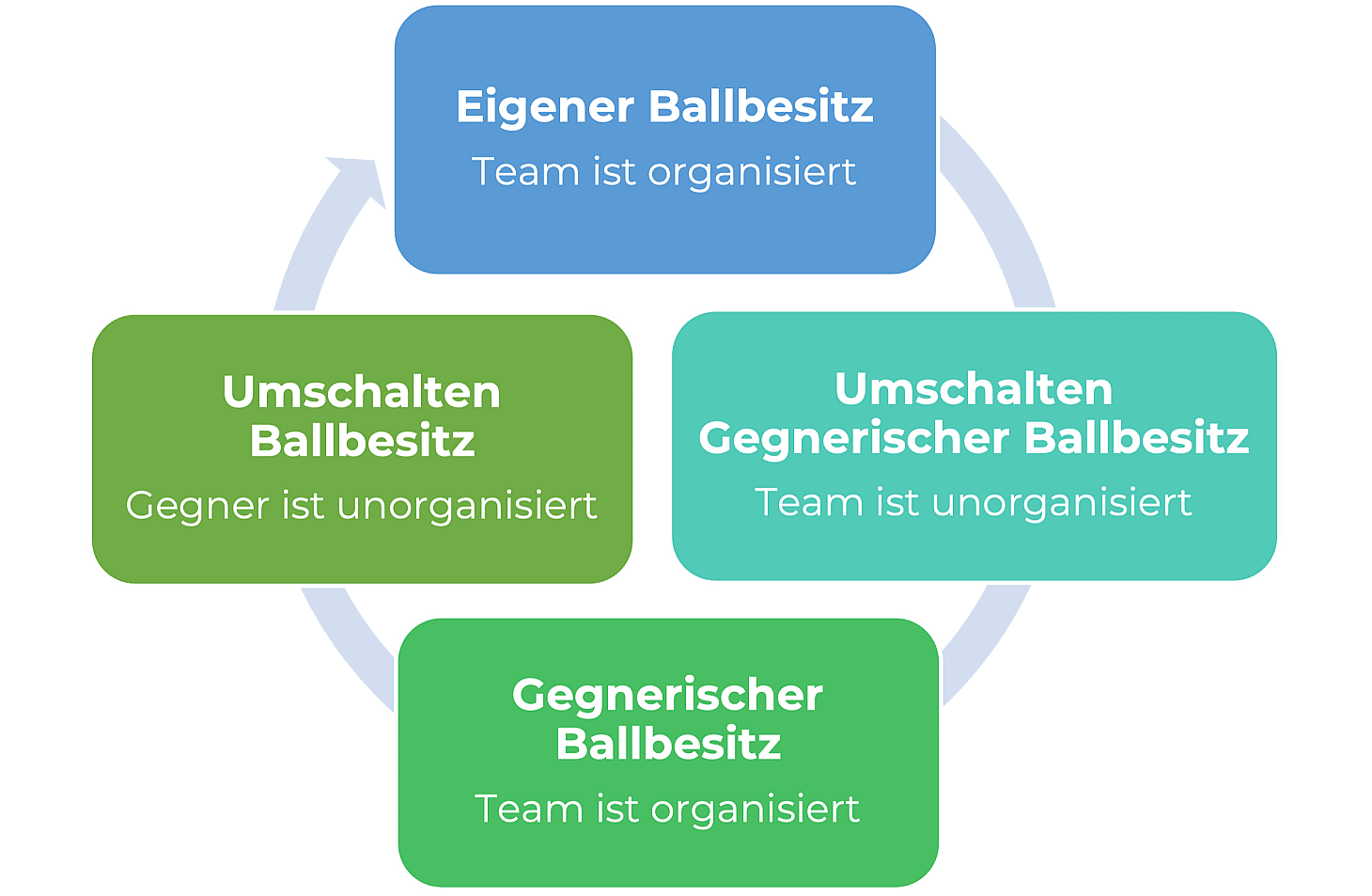Phases of Play in Football
Football is an acyclic sport, meaning that many different actions occur in sequence. Sprints, changes of direction, actions with and without the ball, shots on goal, and much more place high demands on the athlete. In comparison, a sport like marathon running is cyclical, as the same movements are continuously repeated. These different actions in football can be categorized into specific phases of play, which is the focus of this article.
Traditionally, according to Van Gaal, the game is divided into four phases: possession, opposition possession, and two transition phases in between. The Austrian Football Association (ÖFB) adds set-pieces as a fifth phase. Meanwhile, FC Barcelona simplifies the model to just two phases: having the ball or not having the ball. In the following sections, we will explore these different models in more detail.
Van Gaal’s Phases of Play (see graphic)
Most people remember Louis van Gaal as the former coach of Bayern Munich. His illustrious career includes stints at top clubs such as Ajax Amsterdam, FC Barcelona, and Manchester United. He also coached the Dutch national team multiple times. Van Gaal classifies the game into four key phases:
Own Possession:
When a team has possession, both they and the opponent are organized. Through structured positional play, the team in possession attempts to force mistakes from the opposition. While the goal was traditionally described as "creating" goal-scoring opportunities, Van Gaal introduced a new footballing vocabulary with the term "creating" chances in a more refined, planned manner.Transition to Opposition Possession:
This phase occurs after a team loses the ball. At this moment, the team is unorganized and must quickly switch to defensive mode to prevent conceding a goal.Opposition Possession:
The team is now organized in defense, attempting to win the ball back by directing or luring the opposition into making mistakes.Transition to Own Possession:
This phase occurs immediately after regaining possession. The opponent is disorganized, creating an opportunity for the attacking team to exploit. Once the opposing team regains its defensive shape, the game shifts back to Phase 1.
Van Gaal emphasizes that mastering the transition phases offers a huge competitive advantage. As a result, he integrates many transition moments into his training sessions.
ÖFB, DFB: Set-Pieces as a Separate Phase
In coaching courses conducted by the Austrian and German Football Associations (ÖFB and DFB), a fifth phase is added: set-pieces. The reasoning behind this is that set-pieces arise from a stoppage in play and can be trained as a distinct tactical situation. Corner kicks and free kicks near the goal can lead to a disproportionately high number of goal-scoring opportunities. Therefore, heightened focus is required for both offensive and defensive execution.
Barcelona Model
The coaching philosophy at FC Barcelona is guided by a single question: Who has the ball? Barcelona’s well-known playing style revolves around maintaining possession to dominate the game. Thus, the club broadly distinguishes between own possession and opposition possession. Interestingly, the term "defending" has been removed from the La Masia academy’s vocabulary and replaced with "ball hunting," emphasizing the importance of quickly regaining possession. This transition is intensively trained using small-sided games with three teams of different colors in tight spaces.
Compared to Van Gaal’s model, Barcelona’s approach is less rigid. Instead, it encourages players to use the ball as their reference point for positioning and decision-making, allowing them to instinctively make the right choices.
Key Takeaways
All these models highlight the importance of mastering transition moments. The rule is simple: if the opponent is unorganized, attacking becomes easier.
In VOOR’s training exercise database, you can find numerous engaging drills designed to improve quick transitions in your game.

